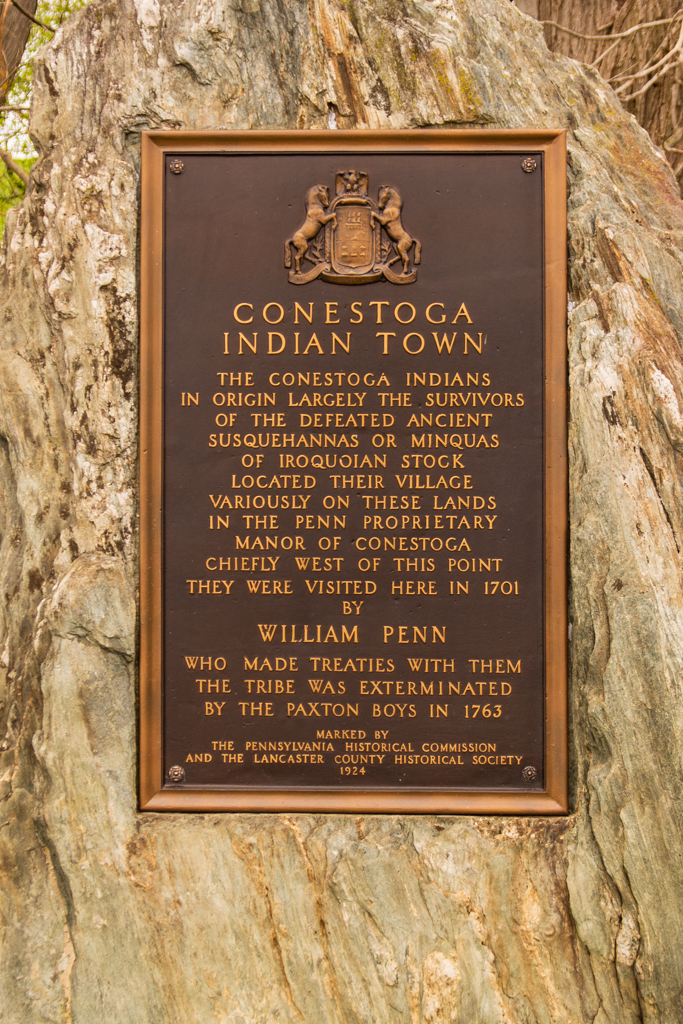
December 14 marks the anniversary of a day of infamy in Lancaster History. It is the day when a band of vigilantes from upriver attacked and destroyed Conestoga Town. The story has been told many times before, not always accurately. If you are interested in the full story, I highly recommend Jack Brubaker’s book Massacre of the Conestogas, On the Trail of the Paxton Boys in Lancaster County. Brubaker does a great job sorting out the true tale from some modified versions.
Just to summarize, the Conestogas were the remnant of the once powerful Minquas or Susquehannocks. But after years of war and attrition the tribe had dwindled to just twenty-two persons. They could no longer hunt for their sustenance, so they had to depend on a meagre income from selling handcrafts like baskets and brooms. They were known personally by their mostly Mennonite neighbors and were not viewed as a threat to anyone.
The situation was different on the upper Susquehanna, however, where bands of Ohio Indians terrorized the colonists on the frontier. News of these attacks made its way down to Harris’ Ferry and Lancaster causing many colonists to be wary of all Indians. The Paxton Rangers were convinced that all Indians were enemies and should be eliminated. As a result, they targeted the Conestoga Indians as a group living too close to colonists for comfort.
It was cold on December 14, 1763, and snow had fallen during the night. Before dawn, the rangers surrounded the village at Conestoga as the residents slept in their huts. At the break of dawn, the rangers burst into the village killing the natives as they lie in their beds. Only seven persons were in the village that morning, the others had spent the night at neighboring farms because of the snow. Six people died and one, a boy named Chrisly escaped to alert the authorities. By the time the authorities arrived, the rangers had already finished their work and left the area.
When the other members of the tribe arrived later in the morning to find their homes burnt and their relatives dead, they wept and did not know what to do or where to go. The Lancaster authorities told them to go into the city where they would be housed in the newly built workhouse on Prince Street. Fourteen people checked in at the workhouse where they were kept under guard to protect them from further attacks.
However, on December 27, the rangers rode into town in broad daylight while the city magistrates were attending a special Christmas service at St. James church. The men stabled their horses at the White Swan hotel on the square, walked down King Street to Prince, and broke into the workhouse. Only the sheriff was standing guard, the jailor having mysteriously disappeared. Being no match for fifty armed men, the sheriff stepped aside and the rangers entered the building and slaughtered everyone inside. Then they walked back up to the hotel, remounted their horses and rode whooping and hollering out of town.
We do not know the names of the Paxton Rangers, they were never identified or charged with any crimes, but we do know the names of the last members of the Conestoga tribe. Here are the twenty last residents of Conestoga Town:
Sheehays, an old man who had met William Penn as a boy and served as chief in the 1750s.
Three sons of Sheehays, Ex-undas, Shae-e-kay, and Ess-canesh.
Wa-a-shen (George Sock), and his brother Tenseedaagua (Will Sock).
Will Sock’s wife and Sheehays’ daughter, Kanianguas (Molly).
A middle-aged woman named Kannenquas.
An older woman named Tea-wonsha-i-ong (Sally).
Sally’s adopted son, Tong-quas (Chrisly).
An old man named Kyunqueagoah (Captain John), and his wife, Koweenasee (Betty).
Koweenasee’s son, Hy-ye-naes (Little Peter).
Kyunqueagoah’s sons Tee-Kau-ley (Harry) and Quaachow (Little John), an unmarried adult.
Saqueis-hat-tah (John Smith) and his wife Chee-na-wan (Peggy).
Three little girls Ko-qoa-e-un-quas (Molly), Canu-kie-sung (Peggy), and Karen-do-uah.
The six who perished on the attack on the village were Sheehays , Wa-a-shen, Tee-Kau-ley, Kannenquas, Tea-wonsha-i-ong, and Ess-canesh. Tong-quas (Chrisly) escaped. The rest, including Chrisly died at the workhouse.
There were two other Conestogas who survived the massacre. There was a couple whose Christianized names were Michael and Mary who lived in a hut on the property of a Mennonite farmer named Christian Hershey. Michael and Mary survived into their eighties and were buried on the Hershey Homestead, now part of Kreider Dairy Farms in Manheim.
Now, I know this is the Christmas season, a time when our focus is on the birth of Jesus with the themes of Peace on Earth and Joy to the World, and I don’t want to be a “Donnie Downer”, but I do think that these last remnants of the area’s first inhabitants should be remembered. So, as you go about your holiday celebrations this year, maybe you could light a candle in memory of the last of the Conestogas.
December 14, 2020 at 6:52 am
Thank you Don.
December 15, 2020 at 10:12 am
I think these Paxton boys killed my gr gr gr grandparents.. can’t remember if they were hallman or Lefevre. The boys traveled by trolly to the pequea area and killed these people in their home.